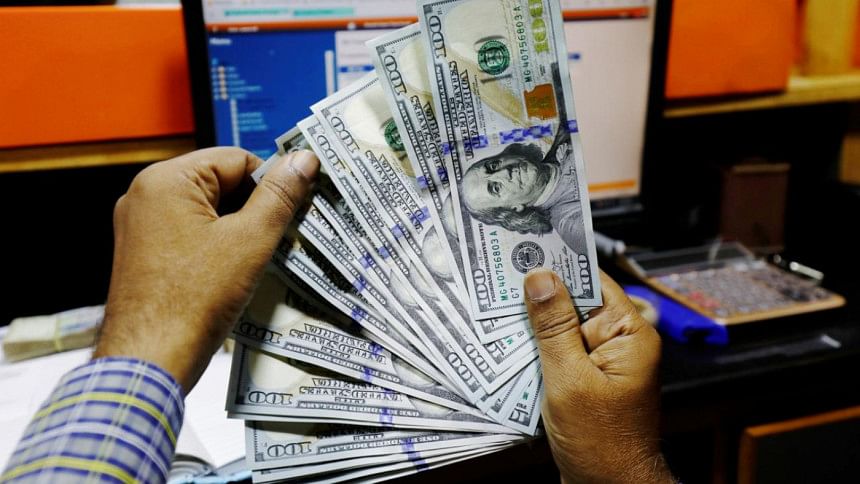Taka policy in a changing world

It is still widely believed that depreciation of taka vis-à-vis foreign currencies—especially US dollar—will boost Bangladesh's export earnings. This is true only if our exports are priced or invoiced in Bangladeshi taka. For example, if a shirt made in Bangladesh is invoiced at Tk 1,000, at an exchange rate of USD 1 = Tk 85, the shirt will cost USD 11.76 in the international market.
Now, suppose taka depreciates in value, with USD 1 equalling Tk 88—a 3.5 percent weakening of taka. At this exchange rate, the Bangladeshi-made shirt will cost USD 11.36, or 3.4 percent cheaper. As can be seen, when exports are priced in the local currency, a depreciation of taka will reflect an almost equal reduction in the price of a locally made shirt. If exchange rates of our competing countries such as India and Vietnam do not change, it is hoped that comparatively cheaper Bangladeshi shirts will lead to higher international demand for shirts followed by higher export earnings.
But our exports are invoiced in US dollar, not in taka. So, a depreciation of taka does not lead to an automatic reduction in the prices of goods that Bangladesh exports. To see this, consider again the example used above. A Bangladeshi-made shirt is priced at USD 11.76 in the international market and the current exchange rate is USD 1 = Tk 85. Now, even if taka depreciates relative to the US dollar, with USD 1 equalling Tk 88, the international price of Bangladeshi shirt remains unchanged at USD 11.76. Other things held constant, the demand for Bangladeshi shirts also remains unchanged as well as its export earnings.
Thus, when exports are invoiced in foreign currencies, as is the case with Bangladesh and many developing countries, changes in the value of taka do not have a direct impact on its export revenues. Instead, when taka depreciates, rather than boosting export revenue, Bangladesh's import prices rise. Higher import prices, in turn, push up the inflation rate at home. Given the large import content of raw materials and other intermediaries in RMG manufacturing, a weak or depreciating taka will thus make the cost of RMG production higher.
The point is simple. If a country's trade (exports and imports alike) is invoiced in foreign currencies, its trade becomes more sensitive to fluctuations in foreign currencies than changes to its own currency. The theory and evidence behind this argument are demonstrated by Harvard economist Gita Gopinath, who is currently serving as chief economist of the International Monetary Fund (IMF).
If a depreciation of the local currency does not boost export, why do Bangladeshi exporters lobby for a weaker taka? To some extent, our exporters suffer from money illusion. When an exporter receives USD 1,000 as a payment for his exports, the equivalent amount in taka is higher if we have a weaker currency (USD 1 = Tk 88 instead of USD 1 = Tk 85). But the higher nominal export earning of Tk 88,000 instead of Tk 85,000 is illusory because due to price inflation, the real purchasing power of Tk 88,000 is less than its nominal value. The only way exporters gain from a weaker taka is when the rate of taka depreciation exceeds that of the increase in price inflation.
Is taka over- or undervalued? Some market observers have pointed out that taka is overvalued. Bangladesh Bank intervenes heavily in the foreign exchange market to keep the value of taka against US dollar stable. If Bangladesh Bank had not intervened, taka per US dollar would have been higher than the current 83-85 range.
A rigorous way to determine whether taka is over- or undervalued is by estimating equilibrium exchange rate models for the taka-dollar exchange rate. In the absence of such models, any conclusion on the value of taka is premature. Moreover, the difference between the official taka-dollar exchange rate and the parallel market rate is less than Tk 2, suggesting that the extent of currency misalignment may not be very severe.
Does Bangladesh Bank follow a "weak taka" or a "strong taka" policy? Up until a few years ago, Bangladesh Bank's exchange rate policy was clearly favouring exporters (i.e. stable but sustained weakening of taka). But sustained economic growth over the past decade has created an affluent consumer group with annual income exceeding USD 5,000. These consumers have a voracious demand for imported goods and services that the country is unable to satisfy.
Consequently, a group of import lobbyists has emerged who prefers a stronger taka to keep import prices under check. The surprising low volatility of the taka-dollar exchange rate trading within a narrow range likely suggests that Bangladesh Bank's exchange rate policy is addressing the concerns of both exporters and importers.
A strong taka not only makes our imports cheaper, our exporters also benefit from cheap imports of raw materials they need. While it may sound counterintuitive, a strong taka may be good news for exporting industries as this may trigger industry restructuring and spur productivity growth. If the Bangladesh Bank is to blame for the loss of export competitiveness due to an overvalued taka, it should also receive credit for its contribution to the country's economic development through cheap imports and lower imported inflation.
Syed Basher is Professor of Economics at East West University.

 For all latest news, follow The Daily Star's Google News channel.
For all latest news, follow The Daily Star's Google News channel. 



Comments